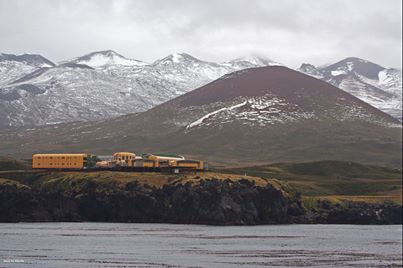Once more it is time for the annual relief of the meteorological station at Marion Island in the southern Indian Ocean. South Africa’s new Antarctic supply and research ship, the S.A. Agulhas II, will depart from Cape Town harbour at 14h00 today and is expected to arrive off the island on 6 April – when offloading by helicopter will commence.

The meteorological/research station on Marion Island above Transvaal Cove, with Junior's Kop and the central snow-covered peaks behind
Photograph courtesy of Marion Island Killer Whales
Among the scientific teams aboard is an experienced one from the University of Cape Town’s FitzPatrick Institute of African Ornithology, led by its newly-appointed Director, Peter Ryan. Accompanying him is Maëlle Connan, who has already spent a year conducting seabird research on the island.
During the three-week relief period ashore “daily diary” loggers will be attached to up to five breeding Wandering Albatrosses Diomedea exulans to study their nocturnal feeding behaviour. The loggers (which can record “14 parameters at infra-second frequencies”) will be attached with Tesa tape to the birds’ tail feathers early in the relief, with the aim of recovering them before the end of the relief as they return to feed their downy chicks after single foraging trips.

Wandering Albatross and chick at Marion Island, photograph by John Cooper
Two field assistants completing the “Fitztitute’s” team, Alexis Osbourne and Vonica Perrold, will remain on the island for a full year, undertaking continued monitoring of long-term study colonies of the four species of albatrosses and the Northern Giant Petrel Macronectes halli – where all the breeding birds are colour-banded.
As in recent years ACAP’s Information Officer is accompanying the annual relief, so expect some stories on ACAP-listed species from the field over the rest of the month. The relief expedition is due to return to Cape Town on 8 May.
With thanks to Peter Ryan for information.
Selected Literature:
Wilson, R.P., Shepard, E.L.C. & Liebsch, N. 2008. Prying into the intimate details of animal lives: use of a daily diary on animals. Endangered Species Research 4: 123-137.
John Cooper, ACAP Information Officer, 02 April 2014

 English
English  Français
Français  Español
Español